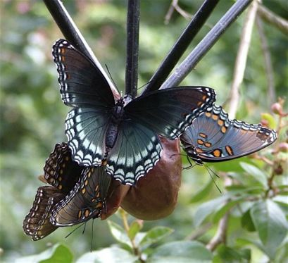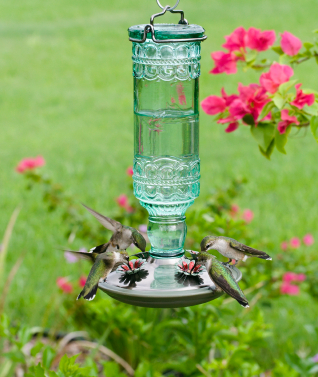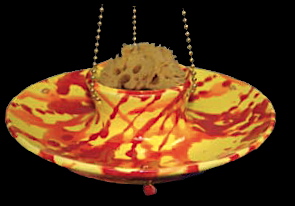- Bats & Butterflies, Bird Accessories, Butterfly Feeder, Fruit Bird Feeder, Squirrel Feeder, Uncategorized
Unusual Butterfly Feeders offer great versatility, and a cool metamorphosis video too!
Love cool stuff! These butterfly feeders(coming soon) do double duty for fruit lovers like; Warblers, Thrashers, Woodpeckers, and lots of other migratory friends who adore fruit and/or jelly. An Oriole’s favorite, the center may be filled with jelly, while orange quarters are placed right along side.
As a nectar feeder for butterflies, the sea sponge is included. It acts as a wick-absorbing the liquid because butterflies will not drink from an open source. This method recreates how the flying gems actually draw nectar from flowers. Over-ripened fruit may also be placed on the outer dish, offering butterflies a varied and swell refuge.
Handcrafted of weather-proof stoneware, lead-free glazes, and brass chain, it’s safe outdoors year-round. The feeder may also be placed in the dishwasher for a quick & thorough cleaning. Lure butterflies to your place offering nectar and fruit together in this groovy, hand-made feeder.
 And speaking of fruit, butterflies enjoy a variety of over-ripened ones. Grapes, oranges, melons, peaches, apples and berries will entice them to nibble and come back for more. This durable stalk feeder is perfect for creating a fruit smorgasbord, even corn on the cob works well in winter after butterfly migration is complete. (Yes… some folks really do feed the squirrels!)
And speaking of fruit, butterflies enjoy a variety of over-ripened ones. Grapes, oranges, melons, peaches, apples and berries will entice them to nibble and come back for more. This durable stalk feeder is perfect for creating a fruit smorgasbord, even corn on the cob works well in winter after butterfly migration is complete. (Yes… some folks really do feed the squirrels!)Of course habitat plays a key role in attracting butterflies, and omitting pesticides will prove most beneficial. Nectar-producing flowers (lantana, abelia, and butterfly bush) are most common, and should be included in the landscape. Host plants are also required, and will likely deteriorate with munching! Milkweed, parsley and cabbage are a few favorites caterpillars love (and need) for growth to chrysalis stage.
Ever witnessed the stages of a butterfly metamorphosis? Until seeing the video below, I can’t say that I have! Truly a masterpiece of nature, it’s worth the watch!
-
Master of Mimicry~A Cool Video from The Cornell Lab
An extremely cool video from The Cornell Lab of Ornithology, one special catbird in California (which is rare in itself) puts on an extreme show. Known as a master of mimicry, over twenty calls are recorded, side by side with the originator…. even a frog!
Pretty common in our parts during summer months, we had several resident catbirds hanging around the yard this season. Digging into suet and a jelly feeder–until the yellow jackets showed up, they then opted for worms meant for bluebirds! Crafty & smart, they’d wait and watch until the open dish melworm feeder came alive once again.
Actually it became obnoxious, as the worms were for the baby bluebirds! But there were breeding pairs nearby and catbird fledges were soon at the feeder too. It sure was a busy season, likely because of diminished food sources and the horrid drought. Two leaf misters ran daily, and nine birdbaths were maintained! It was great having catbirds around, but good to see them move on as well.
Check out the short video below for some excellent catbird knowledge!
-
Extra Hummingbird Feeders…please?
 It’s that time of year again, when the daylight hours start to dwindle, and the southern migrations begin. Most notably, the hummingbird migration, because if you’ve been feeding the little sprites through summer… there’s no way you can miss the frenzy around feeders!
It’s that time of year again, when the daylight hours start to dwindle, and the southern migrations begin. Most notably, the hummingbird migration, because if you’ve been feeding the little sprites through summer… there’s no way you can miss the frenzy around feeders!Activity around hummingbird feeders is just mad! Almost in a frantic, and desperate attempt to guard their spots, hummingbirds are buzzing like crazy, and drinking down nectar from big feeders in a matter of one to two days.
They know it’s critical to fatten up for the long journey back to Central and South America, just imagine how much fuel that takes? And summer weather has not been kind to them…or any other wildlife for that matter 🙁
The brutal temps and severe drought killed off most of the flowers and shrubs that provide nectar. This makes the trip for hummingbirds up North a bit more difficult. They’ll search for activity (other hummingbirds at feeders) as they make their way through the southern states.
Consider adding another feeder, or even two, that will increase the likelihood of more successful flights home. And if you think your hummingbirds are gone, please wait for the slow-pokes and stragglers! Some folks keep feeders out year-round, as strange sitings have revealed the migratory bird in northern states during frigid winter months.
Nectar solutions may also be increased this time of year to benefit hummingbirds. The usual ratio of 4:1 is perfect during lazy summer months, but these guys mean business now! Increase the ratio to a 3:1 solution for added calories. Three cups of water to one cup plain table sugar. If you feed commercial nectar mixes, just use about 25% less water for an added punch.
If hummingbirds graced your yard this year, chances are they’ll be back next year. Practicing “site fidelity” is another really cool thing about these fascinating birds. And hey, even if it’s just one of those little plastic inexpensive hummingbird feeders (that doesn’t much appeal to you) they will absolutely appreciate and love it right now!


